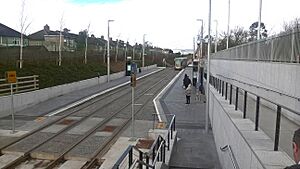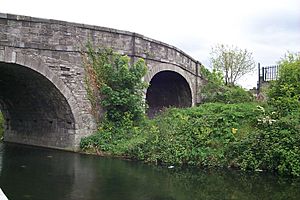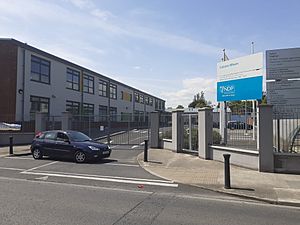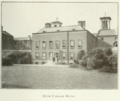Cabra, Dublin facts for kids
Cabra (Irish: An Chabrach, meaning the poor land) is a lively area located on the north side of Dublin city in Ireland. It's about 2 kilometers northwest of the city center. This area is mostly a place where people live, with many homes, schools, and some businesses. Cabra is easy to get to by bus, tram, and train. It sits between the Royal Canal and the famous Phoenix Park.
As of 2022, about 23,681 people live in the Cabra area.
Quick facts for kids
Cabra
An Chabrach
|
|
|---|---|
|
Suburb
|
|
| Country | Ireland |
| Province | Leinster |
| County | Dublin |
| Local authority | Dublin City Council |
| Population
(2022)
|
|
| • Electoral division | 23,681 |
| Time zone | UTC+0 (WET) |
| • Summer (DST) | UTC+1 (IST (WEST)) |
| Irish Grid Reference | O133369 |
Contents
History of Cabra
Early Days and Big Houses
Around the year 1480, a family called the Plunkets owned the land of Cabra. They lived in a castle called Dunsoghly Castle, which you can still see today.
Cabra is actually made up of three smaller areas, or "townlands," that are right next to each other. These three areas met at the gate of a large house called Cabragh House. This house was built in 1598. Later, in 1939, the Dublin City Council bought Cabragh House to build new homes for people. The old house was then taken down.
Growing with Industry
The Industrial Revolution brought big changes to Cabra. In 1790, the Royal Canal was built, running through the northern part of the area. Later, railway lines were also built, connecting Cabra to other places.
From about 1880 to 1930, Cabra was known for its market gardens, where vegetables were grown. It was also a place where cattle were kept before being taken to market. Until the 1920s, Cabra was mostly open fields. Then, many new houses were built, and people from the city center moved to this growing suburb.
Quarry Road got its name from a small quarry that used to be there. This quarry was filled in during the early 1900s.
Where is Cabra?
Cabra is located southwest of the Royal Canal and northeast of the Phoenix Park. It stretches from Phibsboro in the southeast to Ashtown in the northwest. On the other side of the canal are the areas of Glasnevin and Finglas.
Cabra is often thought of as two parts: Cabra East and Cabra West. A railway line helps to divide these two sections. The Bradogue River, a small river that flows into the River Liffey, starts underground at the southern edge of Cabra.
Getting Around Cabra
Cabra has good public transport options, making it easy to travel around Dublin.
Bus Services
Several Dublin Bus routes serve Cabra. The 120 bus goes from Ashtown through Cabra West and East to Parnell Street in the city center. The 122 bus connects Ashington and Cabra to the city and Drimnagh. Other routes like the 38, 37, 39, 70, and 46a also pass through or near Cabra.
Tram System (Luas)
The Luas Green Line, which is Dublin's tram system, has three stops in Cabra: Broombridge, Cabra, and Grangegorman. This line goes through the city center and continues to Cherrywood in South Dublin. You can also connect to other Luas lines in the city center.
Mainline Rail
Cabra has suburban train stops at Broombridge and Pelletstown. These stations offer train services to places like Maynooth railway station and M3 Parkway railway station. You can also catch trains to Dublin city center stations such as Docklands railway station or Dublin Connolly railway station.
Fun Things to Do and Places to Go
Cabra offers several places for recreation and activities.
Parks and Green Spaces
Mount Bernard Park is a public park in East Cabra. It has tennis courts, a basketball court, a small football pitch, a playground, and outdoor exercise equipment. The famous Phoenix Park, Ireland's largest city park, is right next to Cabra's western side. It's home to the President of Ireland and Dublin Zoo. The Royal Canal also runs through Cabra, with a path alongside it perfect for walking and cycling.
Sports Clubs
Naomh Fionnbarra GAA Club is located in Cabra. This club has facilities for traditional Irish sports like hurling, camogie, and Gaelic football.
Community Groups
The Order of Malta Ambulance Corps has a local branch in Cabra. They offer first-aid training and help the community. The Order of Malta Cadets is a group for young people aged 10 to 16, teaching them valuable skills.
Special Places in Cabra
Broom Bridge and a Famous Math Moment
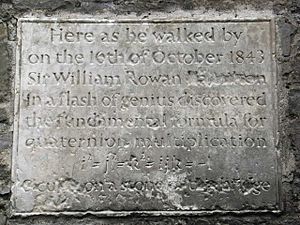
Broom Bridge, also known as Brougham Bridge, crosses the Royal Canal in Cabra. It's named after William Broom, who was involved with the Royal Canal Company. This bridge is famous because of a special moment in math history. On October 16, 1843, a brilliant mathematician named Sir William Rowan Hamilton had a sudden idea while walking here. He quickly wrote down a very important math formula for something called "quaternions" on a stone of the bridge.
A stone plaque on the bridge remembers this moment. It says:
Here as he walked by on the 16th of October 1843 Sir William Rowan Hamilton in a flash of genius discovered the fundamental formula for quaternion multiplication i² = j² = k² = ijk = −1 and cut it on a stone of this bridge.
Because of this, many mathematicians visit Broom Bridge.
Church of Christ the King
The Roman Catholic Church of Christ the King opened in Cabra in 1933. It was designed by John J. Robinson. The church is shaped like a cross and is built with red bricks. It has a large statue of Christ on its tower.
Other Important Buildings
Dublin's public libraries have one of their main offices in Cabra, connected to Cabra Library. This center handles all the books for the city's libraries.
Deaf Village Ireland, which used to be a school for the Deaf, is also in Cabra West. It's a place where many organizations for Deaf people are located, including Deaf Sports Ireland.
Cabra West also has some factories, like the Batchelors beans factory.
Schools in Cabra
Cabra has many schools for different age groups.
Secondary Schools
For older students, there are several secondary schools:
- Coláiste Mhuire: This is an Irish-medium school for both boys and girls.
- St. Declan's College: A Catholic school for boys.
- St. Dominic's College: A Catholic school for girls.
- Cabra Community College: A school for both boys and girls, open to all faiths.
Primary Schools
Younger students can attend primary schools like:
- Gaelscoil Bharra: An Irish-medium school for both boys and girls.
- St Finbarr's BNS: A Catholic school for boys.
- St Catherine's: A Catholic school for girls.
- Christ the King NS: A Catholic school for girls.
Specialized Education
- Holy Family School for the Deaf: Offers both primary and secondary education for students who are deaf or have hearing difficulties.
- Casa Caterina: Provides education for students with autism or special emotional and behavioral needs.
Pre-schools
Naíonra Bharra is an Irish-medium pre-school located on the Gaelscoil Bharra campus.
Famous People from Cabra
Many well-known people come from Cabra, including:
- Singers: Eleanor McEvoy, Dickie Rock, and Angeline Ball.
- Actors: Michael Gambon and Frank Grimes.
- Sports Stars: World champion boxer Steve Collins, WWE world champion Sheamus (Stephen Farrelly), and many footballers like Wayne Henderson, Éamonn Fagan, Liam Whelan, Roddy Collins, Jimmy Conway, and John Conway. Hurler Éamonn Dillon also plays for Dublin GAA.
- Writers: Author and journalist Gene Kerrigan.
- Rappers: Kojaque.
Also, the famous mathematician William Rowan Hamilton, who made important discoveries in algebra, is remembered with a plaque at Broom Bridge in Cabra.
Images for kids
See also
 In Spanish: Cabra (Dublín) para niños
In Spanish: Cabra (Dublín) para niños



